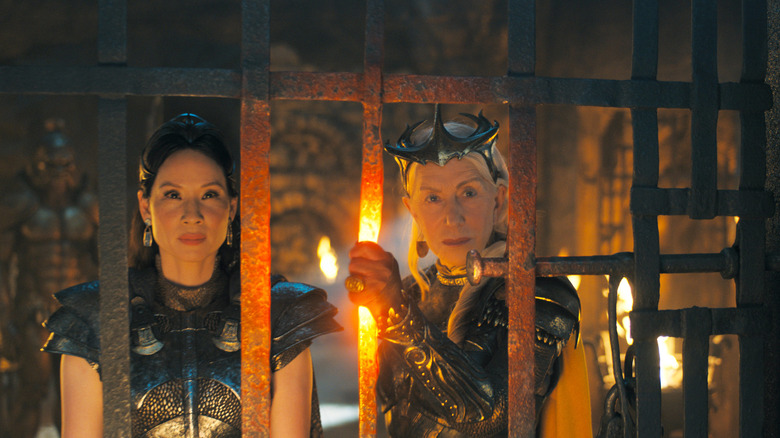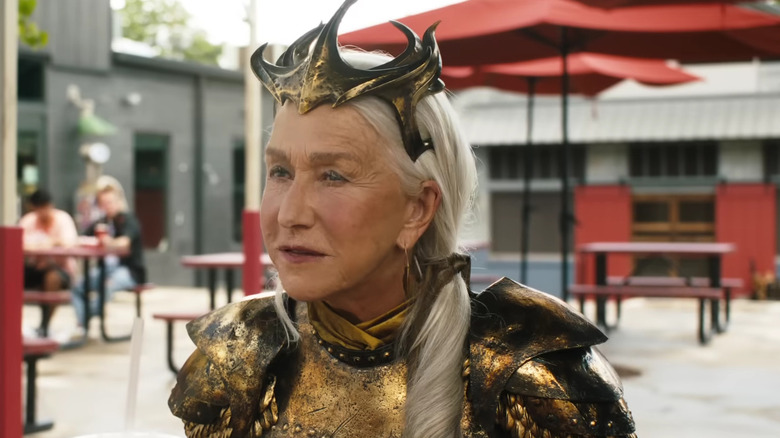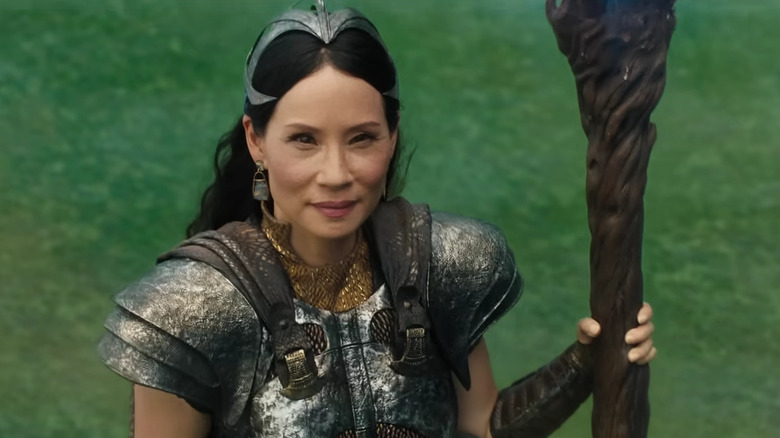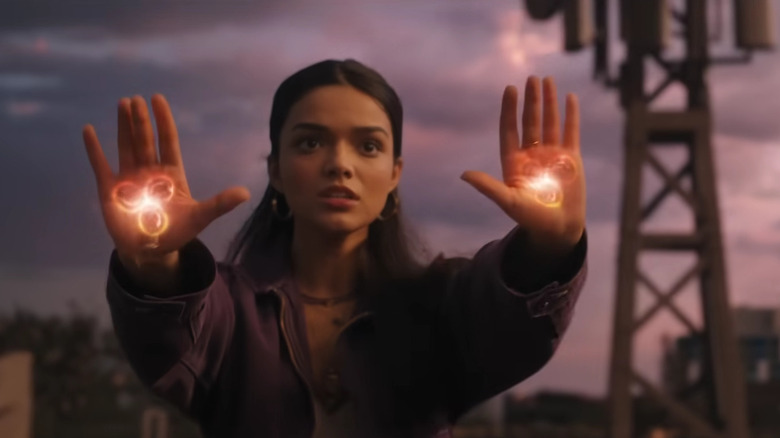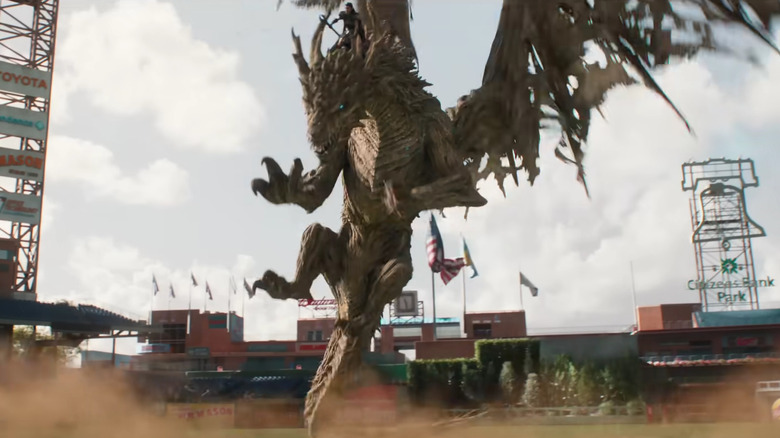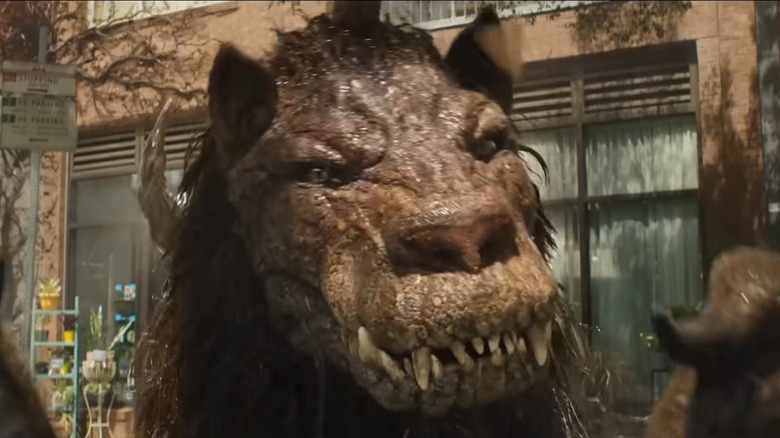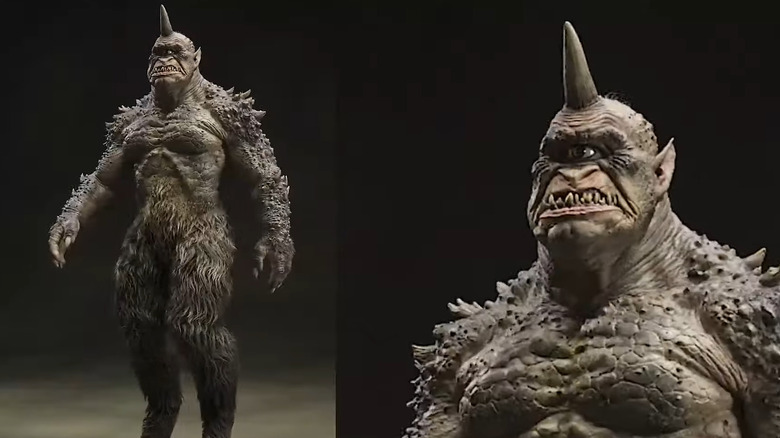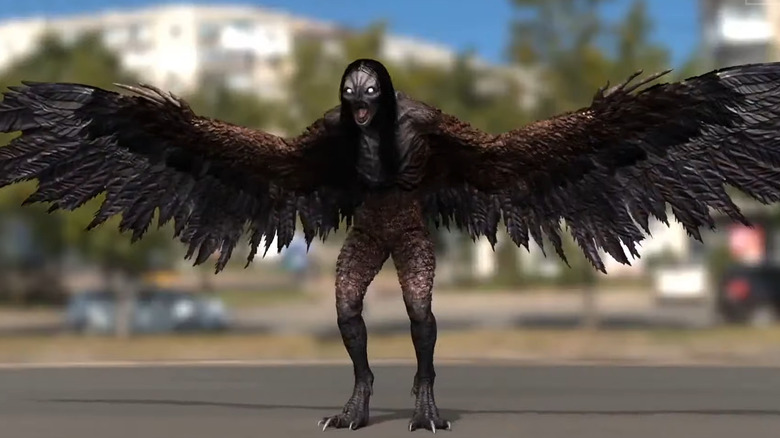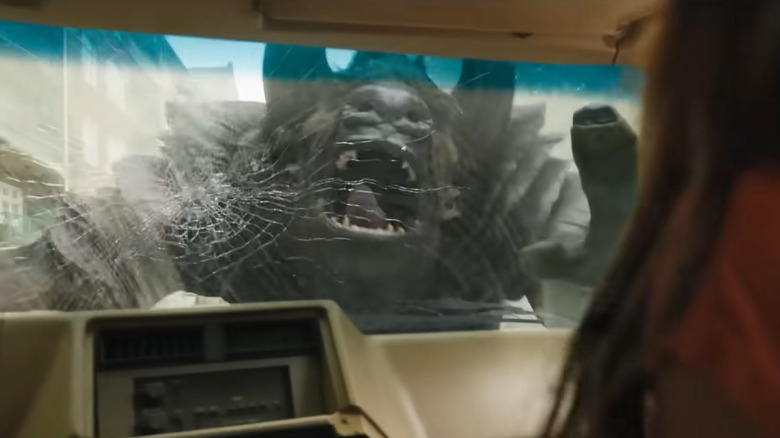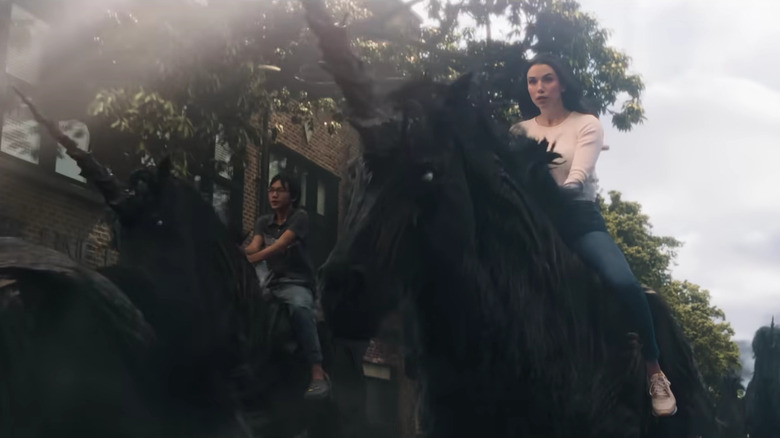A Guide To Mythological Characters And Animals Of Shazam! Fury Of The Gods
The following article contains spoilers for "Shazam! Fury of the Gods."
"Shazam! Fury of the Gods" is in theaters now, and if you've seen it, you know how much it relies on characters and creatures from Greek mythology. Of course, there have been some changes, but from the Daughters of Atlas (Helen Mirren, Lucy Liu, and Rachel Zegler) to Ladon the dragon to manticores, harpies, minotaurs, cyclops, and unicorns, there is a lot of fun lore in here.
In the film, the Daughters of Atlas have come from the Realm of the Gods to find a dangerous artifact — a golden apple from the tree in the Garden of the Hesperides — which could destroy our world. The Shazamily, led by Billy Batson (Asher Angel), aka Shazam (Zachary Levi), have to take them down before they wreck the realm with beings only spoken of in stories and lore. Shazam, the character, is already connected to Greek myth, of course, having the wisdom of Solomon, the strength of Hercules, the stamina of Atlas, the power of Zeus, the courage of Achilles, and the speed of Mercury. One of the Daughters of Atlas even says that children stole the powers of the gods in the trailer.
Let's take a deep dive into the creatures and gods from myth and see how they compare to their film counterparts.
(Please note that there are multiple versions of some of these myths, and I used the most well-known ones.)
Hespera
In "Fury of the Gods," the furious gods are the daughters of Atlas, a Titan forced to hold up the entire sky on his shoulders forever. It happened after the Titanomachy, the battle between the Olympian gods (like Zeus, Hera, Hestia, Poseidon, and Hades) and the older gods like the Titans. In myth, Atlas has many daughters, including Hespera (Helen Mirren) and Kalypso (Lucy Liu), though Anthea (Rachel Zegler) is from another story.
Hespera is one of the Hesperides, or the nymphs of the evening, who take care of a tree of magical golden apples in Hera's garden. The tree and its fruit are guarded by the dragon Ladon (more on him later). If this sounds familiar, it might be because getting some of those apples was one of the labors of the mythological hero Heracles (also known by the Latin name Hercules). He had to get Atlas to retrieve an apple (or several) and was almost tricked into taking the burden of the sky from the Titan.
Another hero, Perseus, had to get weapons from the Hesperides to take down Medusa, the snake-headed goddess whose gaze turned humans to stone. (This happens to the patrons of the Athens Museum at the beginning of the film.) It's interesting to note that in the end, Hespera is the one who is focused on returning to the Realm of the Gods with the apple, despite Kalypso wanting to use it to destroy the human realm. Having all three goddesses in this film be of different ages echoes the concept of the triple goddess: maiden, mother, and crone. For example, we have Persephone, the maiden, Demeter, the mother, and Hecate, the crone. (Don't take "crone" the wrong way. It's about wisdom. Helen Mirren is a goddess already, so I'm sure she knows that.)
Kalypso
Kalypso (which you've likely seen spelled with a C) is another daughter of Atlas. However, in mythos, she doesn't guard the apples as Hespera does with some of their other sisters. Kalypso lives on the island of Ogygia. In Homer's "Odyssey," Odysseus lands on the island as he makes his way home from the long Trojan War. She convinces him to stay with her by singing and mesmerizing him. Odysseus misses his wife Penelope terribly, though, and asks his protector, the Goddess Athena, to help him leave. The gods order Kalypso to help him get resources to leave, which she does, but she rails against them, claiming they don't want gods to have affairs with mortals, something Zeus and the others do with great frequency.
In the film, Kalypso is clearly not a happy goddess, though nothing is mentioned about a lover. That said, it could be the source of some of her anger with humans. She's the most focused of the three sisters on destroying them.
Kalypso has chaos magic, which she activates by speaking in tongues, mesmerizing people. It's similar to her singing in myth. She also rides the dragon Ladon (despite not being connected to him in any tales) and plants the golden apple in the ground, creating a new tree that is twisted and evil in the human realm.
Anthea
Technically Anthea (or Anatheia) isn't Atlas' daughter in mythology, she is one of the three goddesses who were called the Graces. She's the goddess of flowers, plants, and human love. She and her sisters served Aphrodite, the goddess of love and beauty. One of her symbols is honey, and in many of the shots in the film, particularly when she uses her powers, we see a sort of golden, honey-colored light.
In the film, Anthea (going by her alias Anne) enters the same school some of the Shazamily attend. She recognizes the hero inside of Freddy (Jack Dylan Grazer as a kid and Adam Brody as"Captain Everypower") and falls in love with him. She's a goddess of human love specifically, which makes this perfect. She's also the one who cares about the human realm and tries to save it with her power. That power moves around reality, and there is really no one-to-one comparison there with myth. Still — and I know I'm reaching here, but myth connections are one of my favorite things to speculate on — adding plants and flowers to a place does change how they're perceived if my former real estate agent mom's info is anything to go by.
It's interesting to note that the symbol on her hands is a sort of triskele, a triple spiral symbol often associated with the triple goddess.
Ladon the Dragon
The film version of the dragon Ladon appears to be made of wood, with ripped-up wings and a baleful glare. He's ridden in the battle scene by Kalypso (who Shazam calls "Khaleesi" after Daenerys from "Game of Thrones"). In "Fury of the Gods," Ladon is still the dragon guarding the golden apples of the tree in the garden of the Hesperides in the film. However, the mythological Ladon (also called the Drakon Hesperion) differs in that he has 100 heads instead of the one we see in the film. When I spoke to director David F. Sandberg about Ladon during the press junket for "Fury of the Gods," he spoke about the change:
"I was like, 'Oh, it has a hundred heads.' And there was a brief moment there where I was like, 'Can you do a dragon with a hundred heads?' But I was like, 'Well, maybe a lot of tiny heads that create a bigger head, or he had heads all over his body.' But that sort of went away. It's just too crazy. Maybe you could do five heads, 10 heads. But a hundred heads? No."
That sounds like a wise decision, and he was certainly menacing enough with the single head. Ladon also appears in the Heracles myth (otherwise known by the Latin version of his name, Hercules). One of the Labors of Heracles was to get some of the golden apples from the Garden of the Hesperides that the goddess Hera received as a wedding present. In some versions, he offered to hold up the sky for Atlas, who retrieved the apples (then tries to trick Heracles into taking over his job). In others, Heracles kills Ladon himself with a bow and arrow. Ladon was also one of the inspirations for the constellation named Draco.
Manticore
You might not be as familiar with a Manticore as some of the other creatures on this list. This monster has the body of a lion, the tail of a scorpion, and in the film (and some roleplaying games), bat wings. An early description of the creature comes to us from Ctesias, who was a Greek man living in the Persian court who explained that it comes from the Persian word for "man-eater." Of course, he also said that he saw one presented to the Persian court from India (which is sometimes offered as the origin of the creature), so consider that when you're looking at his writings.
In some texts and art, the Manticore has the face of a human, but as you can see from the pic, the movie version has more of a feline face. The Manticore is often described as brown or red. He's actually pretty cute, despite the fact that he'd probably have you for lunch. The Manticore was a popular subject for bestiaries during the Medieval period and, like the unicorns later in this list, was often used in heraldry.
Cyclops
You're probably more familiar with the Cyclopes than the Manticore. These creatures (usually three of them in the myth, but sometimes more) had one eye each. They were giants whose father was Ouranos or Uranus, the God of the Sky, and they were jailed deep in the earth. They were the ones who created the famous lightning bolts of the god Zeus after he released them from their prison. They also made the trident for the sea god Poseidon and the invisibility helm for Hades, the god of the dead.
These one-eyed creatures often liked to have humans for a snack. The most famous of them is Polyphemus, who Homer mentioned in the "Odyssey." They're also sometimes referred to as assistants to Hephaestus, the god of the forge.
Sandberg mentioned in our interview that the designs of the Cyclops and the Harpy were homages to iconic stop-motion artist Ray Harryhausen. His Cyclops in 1958's "The 7th Voyage of Sinbad" has a similar horn on his head, protruding bottom teeth, bumpy skin, pointy ears, and furry lower half.
Harpy
The Harpies are winged female creatures who were also known as the hounds of Zeus. They had the faces of women with the bottom half of birds. They're often described as being the living version of storm winds. Some versions of their myths describe them as ugly, and some as beautiful, but either way, they're very dangerous.
They were mentioned by such luminaries of ancient writing as Hesiod, Aeschylus, and Virgil. Often they were said to steal food and snatch up evildoers. In particular, you hear about the Harpies as dealing out justice to people who have killed their own families.
The Harpies are most famously mentioned in the story of King Phineus of Thrace, who displeased Zeus. He was blinded and sent to an island with lots of food that the Harpies would steal right out of his hands before he could eat. Jason and his Argonauts rescued him. Dante Alighieri mentions them in his "Inferno," where they torture souls who have taken their own lives in the seventh ring of Hell.
As with the Cyclops, Sandberg mentioned them in our interview as being inspired by Ray Harryhausen, who put them in 1963's "Jason and the Argonauts." The ones in "Fury of the Gods" are a little more feathered, whereas Harryhausen's had more bat-like wings.
Minotaur
Of all of the previous creatures, you're likely most familiar with the Minotaur, who was half man, half bull. To summarize this myth ... Pasiphaë, the wife of King Minos, had some sexy time with the Cretan Bull — yes, the actual animal — who was supposed to be sacrificed to the god Poseidon. Minos thought he was so pretty that he kept him alive, and clearly ... ahem ... his wife agreed. She had the master craftsman Daedalus make her a hollow-bodied cow so she could ... oh, dear ... get into it for said sexy time. The result was the Minotaur.
The creature also liked to eat people, so Daedalus created a labyrinth to keep him imprisoned in Minos's Knossos palace. Later on, to stop recurring sacrifices of young Athenians to the Cretan Minotaur, Theseus, the son of King Aegeus of Athens, journeyed to Crete with the other sacrifices to try to kill the beast. While there, Minos's daughter Ariadne falls in love with Theseus and (usually) gives him a ball of thread to help him find his way through the labyrinth to kill the beast and return safely.
In the film, the poor dude gets smooshed by the Shazamily van. Sandberg told me in our interview that the VFX team had to do some design changes because they told him, "'Oh, the legs are actually too small on the Minotaur for him to really walk and do the things we need.' So it's a constant process of figuring out the best look and design of them."
Unicorn
I'm certain that you've heard of the single-horned-equine creatures called unicorns before, but they're probably the Euro-centric version that digs hanging around virgins. However, the creatures have appeared in art dating back to the Bronze Age, beginning around 2000 BCE. They've appeared everywhere from the Indus Valley (though they also might have been depicting a two-horned animal from a side-view) to China. In the West, they were first written about by Ctesias, that Greek man I mentioned earlier, living in Persia. He described them as white-colored "wild asses."
All of these mentions could have been based on other animals like an aurochs or a rhinoceros. During the Middle Ages, narwhal horns (narwhals are whales with a tooth that looks like a long horn on their heads) were often sold as unicorn horns.
Oddly enough, these magical creatures weren't considered mythological in Greek writings but actual animals. In more modern stories, they're gentle creatures and symbols of love and marriage. They're even mentioned in the Judeo-Christian Bible and Chinese mythology.
This version, however, is more of a murder unicorn. (That's what Sandberg called them in our interview.) Western unicorns were tamed in myth by having a woman sit down to lure him to put his horned head in her lap (I can't imagine what that is supposed to symbolize). The unicorns from "Fury of the Gods" enjoy sweet food like ambrosia, the mythical food of the Greek gods. The film uses Skittles to tame them, which fits perfectly with that brand's weird commercials.
"Shazam! Fury of the Gods" is in theaters now.
